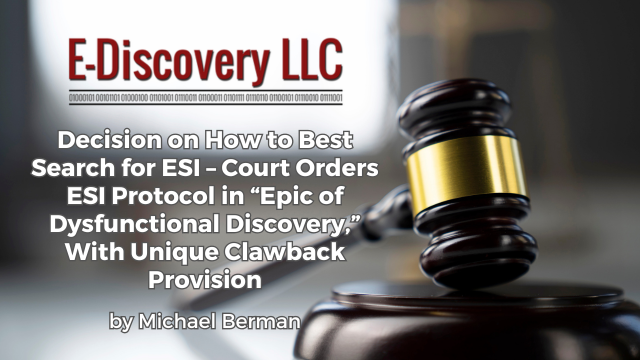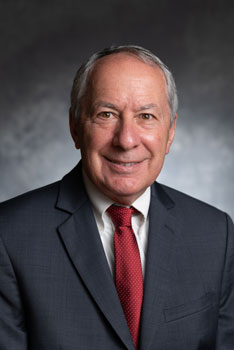
[EDRM Editor’s Note: The opinions and positions are those of Michael Berman.]
In a case where the plaintiff seeks $24,000,000 in damages, the court stated: “Today we write the next chapter in this litigation, a case which threatens to become an epic of dysfunctional discovery…. The parties have long been embroiled in contentious discovery disputes.” Everlast Roofing, Inc. v. Wilson, 2025 WL 1959345 (M.D. Pa. Jul. 16, 2025). In addition to ordering an ESI Protocol, while providing an escape valve, the court ordered a unique provision permitting clawback of irrelevant documents that were produced.
YOU MAY BE RIGHT, BUT STILL LOSE
The Everlast Roofing decision illustrates the maxim that: “[I]t is often a futile gesture to draw a line in the sand and cling to a position in a discovery dispute.” Sometimes Discovery Disputes Do Not Bring Out the Best in Us – Part II, quoting Gill, et al., v. CVS Health Corp. et al., 2024 WL 3028958 (N.D. Ill. June 17, 2024).
Similarly, a court wrote that “it would be in the parties’ interest to reach a negotiated result. It should not be forgotten that a party could be ‘right,’ but find itself on the losing side of a court’s ruling.” There’s No Right or Wrong Answer – But There Are Mistakes (Apr. 19, 2024), quoting Rayome v. ABT Electronics, 2024 WL 1435098 (N.D. Ill. Apr. 3, 2024).
The Hon. Andrew Peck (ret.) has light-heartedly often referred to “Rule 1.1” which is “don’t piss off the Judge.”
COURT-ORDERED ESI PROTOCOL
Everlast Roofing is an example of the benefits of a negotiated agreement. One issue presented in this “disputatious discovery process” was “how to best search for electronically stored information (ESI)….” Id. at *1. The parties could not reach an agreement. Therefore, the court imposed one, while providing an escape hatch.
The Everlast Roofing court ordered the parties to enter an ESI Protocol and it specified the relevant terms of that Protocol.1 It wrote:
We have repeatedly endeavored to instill in the parties a mutual commitment to cooperatively working together to resolve discovery issues in a collaborative fashion. However, to date, our entreaties seem to have largely fallen on deaf ears. Indeed, it is emblematic of the parties’ inability to cooperate and communicate that their latest submissions concerning the ESI issues in this case contain two utterly irreconcilable competing narratives regarding the course of an in-person meet and confer. It is frankly astonishing that these litigants are unable to come away from an in person meeting with a common understanding of what they have said or agreed to do. Counsel can, should, and must do better. However, in light of their current communication shortcomings, it will fall to us to resolve these discovery issues.
Everlast Roofing, Inc. v. Wilson, 2025 WL 1959345 (M.D. Pa. Jul. 16, 2025).
It is frankly astonishing that these litigants are unable to come away from an in person meeting with a common understanding of what they have said or agreed to do. Counsel can, should, and must do better.
Everlast Roofing, Inc. v. Wilson, 2025 WL 1959345 (M.D. Pa. Jul. 16, 2025).
The Prior Decision in Everlast Roofing
The ESI discovery dispute centered on two discovery requests. In a prior proceeding, the parties had presented markedly different metrics. The court wrote: “Accordingly, when the parties’ respective positions on these two sets of requests were combined there was a gulf of more than 100,000 records between the defendants’ contention that there are a combined 104,500 responsive documents and Everlast’s view [that] only 2,000 relevant records existed.”
In the prior proceeding, the Everlast Roofing court entered an order “which noted that there were ample reasons to be skeptical of either of the extreme positions posited by the parties and told counsel that ‘the parties’ own submissions reveal that they have more work to do if they wish to comply with the Sedona principles which guide ESI discovery.’” Id. at *3.
At that time, the Everlast Roofing court ordered the parties to meet and confer in person “to develop and fully implement a collaborative data-driven sample testing strategy to determine which of the remaining approximately 100,000 records identified by the defendants’ search terms may also be relevant and proportionate to the needs of this case.”2
The Current Decision in Everlast Roofing
In the current decision, the court wrote that the parties submittals “reveal that they have to an astonishing degree failed in this task…. Indeed, the extraordinary degree of their mutual dysfunction is exemplified by the fact that in their warring submissions counsel cannot even agree upon what they are alleged to have agreed to in their meet and confer session. Frankly this inability to perform even rudimentary tasks should be a source of chagrin for all involved.” Id. at *3 (emphasis in original).
In situations where parties reach impasse, some courts have ordered that parties record or transcribe their meet and confer sessions. Felder: Part 1 of 4: Court-Ordered Transcription of “Meet and Confer” Session (Aug. 13, 2024)(“While recording Rule 26(f) conferences has been described as a ‘drastic measure,’ the late Judge Waxse suggested that ‘[j]ust the idea that I’ll be watching it seems to put [participants] all on their best behavior and suddenly they have an agreement.’”); Sometimes Discovery Disputes Do Not Bring Out the Best in Us – Part II (Jun. 20, 2024); but cf. How Not to Negotiate an ESI Protocol? Say it is “Mandatory”; and, Demand That Discussions be Recorded (Mar. 26, 2025).
While the on-the-record technique may be effective, the Everlast Roofing court took a different approach, writing:
In reviewing the parties’ competing submissions it is clear that they are unable to agree on the following basic aspects of an ESI protocol: (1) cost sharing for the expense of discovery; (2) procedures for culling and refining samples from the 100,000 disputed documents; (3) whether the documents should be produced in a native format with metadata; (4) which counsel will review the documents for relevance; (5) how many counsel will be involved in this discovery process; (6) how to dispose of documents that all parties agree are irrelevant; and (7) whether counsel should be required to exchange affidavits relating to this process. Therefore, in the absence of any reasoned approach by counsel to these questions, we will address these issues for the parties.
Id.
The Everlast Roofing court proceeded to rule on each disputed topic and ordered that the parties implement an ESI Protocol conforming to its decisions. Id. at *4-5.
However, the court also provided an escape hatch, stating: “Finally, we note that while the inability of the parties to resolve these issues has compelled us to frame their ESI search procedure for them, nothing in this order prevents the parties from now doing what we have ordered them to do: adopt a mutually agreeable ESI search process.”
Finally, we note that while the inability of the parties to resolve these issues has compelled us to frame their ESI search procedure for them, nothing in this order prevents the parties from now doing what we have ordered them to do: adopt a mutually agreeable ESI search process.
Everlast Roofing, Inc. v. Wilson, 2025 WL 1959345 (M.D. Pa. Jul. 16, 2025).
Cost Sharing in Everlast Roofing
On cost sharing, the court ordered “the parties to share the costs of future ESI discovery as part of any ESI protocol.”
Cost-sharing has a long history. Historical ESI Highlights – Part II – Zubulake (May 25, 2022); Fed.R.Civ.P. 26(c)(1)(B)(protective order may allocate expenses of discovery). It is well-settled that: “[T]he presumption is that the responding party must bear the expense of complying with discovery requests, but he [or she] may invoke the district court’s discretion under Rule 26(c) to grant orders protecting him [or her] from ‘undue burden or expense’ in doing so, including orders conditioning discovery on the requesting party’s payment of the costs of discovery.” Oppenheimer Fund, Inc. v. Sanders, 437 U.S. 340, 358 (1978).
While the Everlast Roofing court’s “mutually assured destruction”3 approach may foster proportionality, cost sharing may have significant detrimental consequences, especially in asymmetrical litigation. For example, Ms. Laura Zubulake reported that the cost sharing decision in her landmark lawsuit nearly priced her out of the courthouse. Book Review: “Zubulake’s e-Discovery: The Untold Story of My Search for Justice,” by Ms. Laura A. Zubulake (Aug. 18, 2012)(“In reality, I struggled to fund the litigation and pay my personal bills.”… When the Court’s cost-sharing decision was announced, her 25% share came to $40,000, “a staggering sum for an unemployed person,” while UBS Warburg’s share was $120,000, a small fraction of its resources.).
A more middle-of-the-road approach to cost-sharing was ordered in Golden Oldie #2 – 40 Hours of Searching is Enough (Apr. 17, 2025), citing Marens v. Carrabba’s Italian Grill, Inc., 196 F.R.D. 35 (D. Md. 2000)(Grimm, J.). There a producing party was ordered to expend 40 hours in responding and produce a good faith affidavit. The requesting party could ask for more, but it would have to pay the costs.
The Metadata Issue and Cost Sharing
Turning to the metadata issue, defendants sought native production (of course, with metadata), and based on its cost sharing ruling, the court so ordered. Cf. All Metadata is Not Equal – Court Orders Narrower Request (Jun. 17, 2025).
Sampling and TAR
As to sampling, the Everlast Roofing court held that “the parties’ ESI protocol should draw upon a statistically valid random sample and then include a TAR procedure aimed at using this smaller sample to define search parameters which achieve a 95% accuracy rate when reviewing these records.”
“Clawback” of Irrelevant Documents
In a unique holding, the Everlast Roofing court ordered “clawback” protection for irrelevant documents that were produced, writing:
These ESI discovery procedures will inevitably entail some disclosures of documents that are not relevant, particularly as parties refine their search parameters. Therefore, the parties’ ESI protocol must provide for the prompt return or destruction of irrelevant information.
Id.
While I am not suggesting that the court lacked authority for this order, Fed.R.Civ.P. 26(b)(5)(B)’s clawback reaches only privileged information. One may assume that, because irrelevant information is beyond the scope of discovery under Rule 26(b)(1)(the scope of discovery is information “relevant to any party’s claim or defense and proportional”), irrelevant documents are not discoverable and subject to an agreed-upon clawback process.
Review by Counsel and Requested Affidavits by Counsel
Faced with a dispute over which counsel, and how many, may review samples culled in the process, the court wrote: “On this score, we conclude that the parties must implement procedures which provide for mutual inspection of any samples drawn from these disputed records to determine sample relevance and refine search parameters…. We will not impose any limitations on the number of counsel that each party may assign to this task.” [citation omitted].
The court then entered a reciprocal order on the request for affidavits of counsel:
The enmity and distrust between these parties is illustrated by the suggestion that some counsel should be required to submit affidavits attesting under oath to certain aspects of this ESI discovery process. Attorneys are officers of the court, who have a legal and ethical duty of candor to the court and opposing counsel. In light of these longstanding legal ethical obligations, we do not regard the exchange of affidavits as necessary; however, if one party insists on affidavit from opposing counsel, then all parties will be required upon request to swear out affidavits.
Id.
That seems to be a Solomon-like resolution of the affidavit-of-counsel issue. I have suggested that, given the parameters of Fed.R.Civ.P. 26(g)(1)(B), a sworn statement is surplusage. Sometimes Discovery Disputes Do Not Bring Out the Best in Us (Apr. 10, 2024); see also Counsel Not Required to Swear to Having Met Discovery Obligations (Jan. 4, 2025); but cf. Two Recent Decisions Imposing Sanctions for Discovery Failures (Dec. 16, 2024)(“To impress upon them the gravity of the claims they made in their pleadings, the court put both [plaintiff’s counsel] West and [new defense counsel] Goetzl under oath.”).
In light of these longstanding legal ethical obligations, we do not regard the exchange of affidavits as necessary; however, if one party insists on affidavit from opposing counsel, then all parties will be required upon request to swear out affidavits.
Everlast Roofing, Inc. v. Wilson, 2025 WL 1959345 (M.D. Pa. Jul. 16, 2025).
In Kyle Rayome v. ABT Electronics, 2024 WL 1435098 (N.D. Ill. 2024), the court wrote that it “would prefer this case not go to the dark place where attorneys on one side demand that the attorneys on the other side provide declarations in which they swear they are telling the truth about complying with their discovery obligations.” See What Happens When Parties Fail to Negotiate a Privilege Log in Good Faith? (Apr. 8, 2024). The Everlast Roofing court appears to have avoided that “dark place.”
CONCLUSION
The Hon. Paul W. Grimm (ret.) has long advocated cooperation and also stated that cooperation does not require capitulation. See P. Grimm, “Practical Ways to Achieve Proportionality During Discovery and Reduce Costs in the Pretrial Phase of Federal Civil Cases,” 51 Akron L. Rev. 721, 736–37 (2017); M. Berman and P. Grimm, “The Duty to Cooperate in Discovery,” in M. Berman, et al., eds., “Electronically Stored Information in Maryland Courts” (Md. State Bar Ass’n. 2020), 340, 347.
I agree with the philosophy of the court that wrote:
Though the Court dreams of a world in which litigants amicably resolve all discovery disagreements, disputes over the proper bounds of discovery are a fact of litigation. The Court stands ready and willing to mediate such legitimate disputes. In doing so, the Court aims to, where possible, work with the parties to find a mutually agreeable path forward, to avoid needlessly wasting the Court’s and the parties’ resources on unnecessary motion practice.
Sometimes Discovery Disputes Do Not Bring Out the Best in Us, quoting Wilshire Ins. Co. v. Airport Restaurant, LLC, 2024 WL 1466378 (M.D. Fl. Apr. 4, 2024).
While the Everlast Roofing dispute may have been too complex,4 many courts also offer prompt and informal resolution of discovery disputes. Procedures to Avoid, and Promptly Resolve, Discovery Disputes in the District of Maryland (Dec. 22, 2023); Court Uses an Informal Discovery Procedure to Hold That Untimely Objections Were Waived, and Answers to Interrogatories Defectively Referred to Deposition (Nov. 1, 2023).
Notes
- A court-ordered ESI Protocol is not an infrequent outcome of ESI disputes. See Litigants Can’t Agree; Judge Entered an ESI Protocol; Party Objected to It; Objections Overruled (May 17, 2025); Failure to Cooperate Leads to Judicially-Imposed ESI Protocol (Jan. 15, 2025). ↩︎
- Orders to meet, confer, and, cooperate are not uncommon. Parties Ordered to Cooperate in Good Faith and Develop a “Discovery Plan” (May 25, 2024). ↩︎
- “[M]utual assured destruction, [is a] principle of deterrence founded on the notion that a nuclear attack by one superpower would be met with an overwhelming nuclear counterattack such that both the attacker and the defender would be annihilated.” Mutual assured destruction (MAD) | Definition, History, & Cold War | Britannica. Because of that awful outcome, the theory posited that both sides would be compelled to act reasonably. ↩︎
- I intend no criticism of either counsel or the Everlast Roofing court in this blog. Instead, I highlight some possible off-ramps and alternatives. ↩︎
Assisted by GAI and LLM Technologies per EDRM GAI and LLM Policy.


